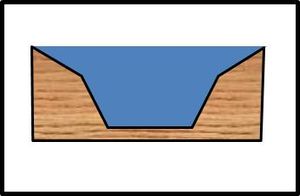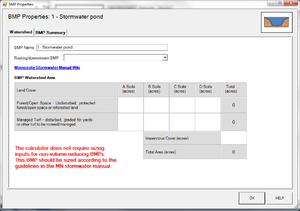
Requirements, recommendations and information for using stormwater pond as a BMP in the MIDS calculator
The anticipated construction period for this page is through September, 2014
A constructed stormwater pond is a non-volume reducing BMP. While this BMP does not provide stormwater volume reduction toward the performance goal or on an annual basis, it does provide annual pollutant load reductions. Annual pollutant reductions are applied in three levels based on pond design.
Contents
MIDS calculator user inputs for constructed stormwater pond
For constructed stormwater pond BMP, the user must input the following parameters to calculate the pollutant load reductions associated with the BMP.
- Watershed tab
- BMP Name: this cell is auto-filled but can be changed by the user.
- Routing/downstream BMP: if this BMP is part of a treatment train and water is being routed from this BMP to another BMP, the user selects the name of the BMP from the dropdown box to which water is being routed. All water must be routed to a single downstream BMP. Note that the user must include the BMP receiving the routed water in the Schematic or the BMP will not appear in the dropdown box.
- BMP Watershed Area: BMP watershed areas are the areas draining directly to the BMP. Values can be added for four soil types (Hydrologic Soil Groups (HSG) A, B, C, D) and for three Land Cover types (Forest/Open Space, Managed Turf and impervious). The surface area of the BMP should NOT be included in the watershed area of the BMP. It is assumed that precipitation and evapotranspiration at the surface of these systems are neutralizing and that pollutant load additions from precipitation alone are minimal. Units are in acres.
- BMP Parameters tab
- Pond Design Level: Select Design Level 1, Design Level 2, or Design Level 3 to determine pollutant load reductions for this BMP. Design level requirements are explained in the pollutant reduction section.
- BMP Summary Tab: The BMP Summary tab summarizes the volume and pollutant reductions provided by the specific BMP. It details the performance goal volume reductions and annual average volume, dissolved P, particulate P, and TSS load reductions. Included in the summary are the total volume and pollutant loads received by the BMP from its direct watershed, from upstream BMPs and a combined value of the two. Also included in the summary, are the volume and pollutant load reductions provided by the BMP, in addition to the volume and pollutant loads that exit the BMP through the outflow. This outflow load and volume is what is routed to the downstream BMP if one is defined in the Watershed tab. Finally, percent reductions are provided for the percent of the performance goal achieved, percent annual runoff volume retained, total percent annual particulate phosphorus reduction, total percent annual dissolved phosphorus reduction, total percent annual TP reduction, and total percent annual TSS reduction.
Methodology
Required Treatment Volume
Required treatment volume, or the volume of stormwater runoff delivered to the BMP, equals the performance goal (1.1 inches or user-specified performance goal) times the impervious area draining to the BMP. This stormwater is delivered to the BMP instantaneously following the Kerplunk method.
Volume Reduction
This BMP does not provide volume reduction towards the performance goal.
Pollutant Reduction
Pollutant load reductions are calculated on an annual basis. A stormwater pond does not provide annual stormwater volume reduction. Annual pollutant load reductions are applied based on the selected Design Level. To apply a design level in the calculator the constructed stormwater pond must meet the following design requirements.
- Design Level 1 (TSS = 60%, DP = 0%, PP =62%, TP = 34%): Must meet all of the design requirements for Design Level 1 and does not meet all design requirements for Design Level 2.
- Dead (or permanent) storage of at least 1800 cubic feet per acre that drains to the pond
- The pond’s permanent storage volume must reach a minimum depth of at least 3 feet and must have no depth greater than 10 feet. The basin must be configured such that scour or resuspension of solids is minimized.
- Discharge rate of water quality volume does not exceed 5.66 cubic feet per second per acre of surface area of the pond.
- Design Level 2 (TSS = 84%, DP = 8%, PP = 84%, TP = 50%): Meets all of the requirements for Design Levels 1 and 2 and does not meet all design requirements for Design Level 3
- Sediment forebay at all major inflows
- Water quality volume (flood pool volume) >= 1 inch of impervious area
- Flow path length to pond width ratio >= 1:1
- Pond does not intersect with the groundwater
- Design Level 3 (TSS 90%, DP = 23%, PP = 90%, TP = 60%): Must meet all of the design requirements for Design Levels 1, 2 and 3.
- Wet extended detention or multi-cell system
- Flow path length to pond width ratio >= 1.5:1
- Water quality volume (flood pool volume) > 1.5 inch of impervious area
NOTE: The user can modify event mean concentrations (EMCs) on the Site Information tab in the calculator. Default concentrations are 54.5 milligrams per liter for total suspended solids (TSS) and 0.3 milligrams per liter for total phosphorus (particulate plus dissolved). The calculator will notify the user if the default is changed. Changing the default EMC will result in changes to the total pounds of pollutant reduced.
Routing
A constructed stormwater pond can be routed to any other BMP except for a green roof and a swale side slope or any BMP in a treatment sequence that would cause stormwater to be rerouted back to the stormwater pond already in the sequence. All BMPs except for a swale side slope can be routed to a constructed stormwater pond.
Assumptions for constructed stormwater pond
The following general assumptions apply in calculating the credit for a stormwater pond. If these assumptions are not followed, the pollutant reduction credits cannot be applied.
- The constructed stormwater pond has been properly designed, constructed and will be properly maintained.
- The constructed stomwater pond meets all design requirements for the selected Design Level.

